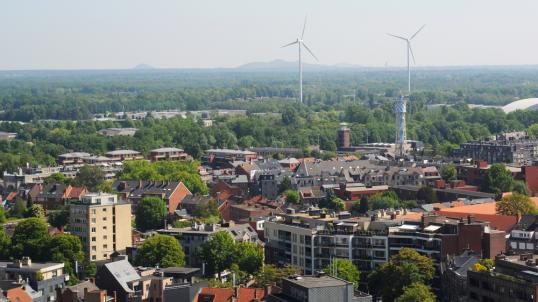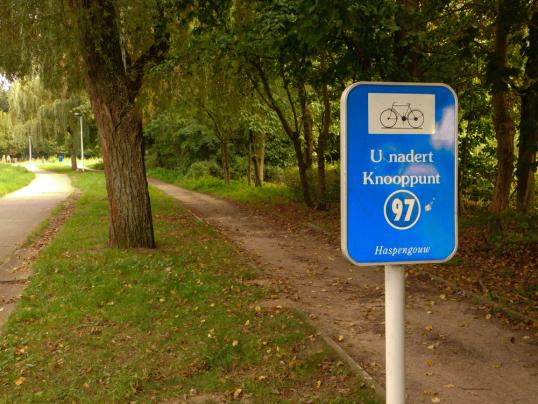- Topic
- Urban mobility planning
- Country
- Belgium
- Resource type
- Case study
First published on 13 March 2019.
The Belgian cities of Hasselt and Genk have developed a combined Sustainable Urban Mobility Plan (SUMP), championing the notion that ‘mobility does not stop at the borders of a municipality’. The neighbouring cities worked together to design the SUMP. They took a spatial network approach to promote the use of public transport, inspire active mobility and discourage the use of heavily-polluting private vehicles. Implemented in 2014, the joint SUMP will be evaluated in full by the municipalities in 2019.
Context
Genk and Hasselt are neighbouring cities are the Flanders region of Belgium.
Hasselt
Hasselt is the capital city of the province of Limburg. It is located in north-east Belgium and has approximately 75 000 inhabitants. The city is enclosed by two ring roads, which helps to limit traffic in the largely pedestrianised city centre and surrounding residential areas. Hasselt first implemented a mobility plan in 1999 and has implemented a range of relevant actions, including:
- providing free public transport between 1997 and 2013, contributing to a rise in bus passengers from 1 000 a day in 1997 to an average of 12 600 a day in 2007;
- reintroducing fares in 2014, but certain groups still have access to free public transport (i.e. 0-19-year-olds, people over 65 and individuals with disabilities);
- Hasselt implemented ‘I Bike, I Move’ in 2009, which offers free bicycle rental from Monday to Saturday, along with secure, sheltered bicycle parking that is equipped with repair services to support the uptake of cycling in the workplace;
- ‘CityDepot’ provides solutions for freight companies to replace heavily-polluting vehicles with electric trucks and cargo bikes for use in and around the city centre.
In 2013, the modal split for commuting journeys was 78 % by car, 11 % by bicycle and 5 % by public transport. The majority of journeys between home and school (36 %) were completed by bicycle, 35 % by car, 19 % by public transport and 8 % by walking. In spite of investment in public transport and active mobility, there remained great potential to build on these measures and encourage future investment through the development of a SUMP.
Genk
Genk is home to 65 000 people and was a hub for mining in the early 20th century. Despite the demise of the mining industry, Genk is still considered to be the industrial hub of Limburg, providing over 45 000 jobs. In contrast to Hasselt, Genk employed minimal sustainable transport measures prior to 2014. In 2000, the majority of commuter trips were undertaken by private cars (70 %), followed by public transport (15 %), bicycle (10 %) and walking (5 %). As such, in 2014, there was significant scope to promote the use of sustainable transport among the population by providing infrastructure and complementary measures.
In action
Given the close proximity of Hasselt and Genk, and the importance of both regions to Limburg, it was sensible to implement a joint SUMP (alongside individual mobility plans that take account of the specific needs of the cities). The SUMP was developed by the Flemish regional government, Genk and Hasselt municipalities and a public transport company (De Lijn).
The joint SUMP provides a mobility vision at the regional level, providing guidelines and preconditions for the respective local mobility plans and was developed using local knowledge. The focus was on prioritising active and public transport with tourism and recreational use in mind while keeping the key principles of limiting emissions and improving traffic safety at the forefront of the SUMP. The SUMP:
- prioritises cycling and implements cycle paths, crossings and signposts;
- aims to create an uninterrupted cycling network linking the cities;
- encourages residents to switch mode to public transport and active travel.
The SUMP comprises three key work domains:
- spatial developments;
- networks;
- supporting measures.
The SUMP outlines clearly the various work packages:
- spatial mobility and planning,
- categorisation and renovation of roads;
- construction of cycle routes.
In addition, supporting measures are considered, including the pricing of public transport; and the implementation of transport management for schools, events, and services and promotional measures. The necessary enforcement of transport measures is also addressed.
Results
Although the joint SUMP has yet to undergo formal evaluation, initial successes are evident in the implementation of several infrastructural and policy-related measures in the cities – detailed below.
Genk
Active transport
- 300 km of separated cycling infrastructure and a further 75 km of mixed cycling infrastructure.
- Cycling uptake is supported by signposting to neighbourhoods and significant sites, and the implementation of bicycle sharing schemes.
- Mobit bicycles are available throughout the city for users to borrow.
- Blue-bikes are available at Genk railway station.
- Sheltered bicycle parking provided at Genk railway station.
- Bicycle sheds surround the city’s pedestrian zone.
Public transport
- Development of an extensive public transportation network reaching 93 % of residential areas.
- The addition of 20 electric vehicle charging points across the city (with a further eight planned by 2020).
- Charging points are provided across the city in public car parks.
- Residents can apply for a charging station to be installed near their property, should their nearest charging station be more than 500 metres away and there is inadequate space for a charging point on their property.
Hasselt
Active transport
- Over 20 free parking spaces for electric vehicles.
- Internal combustion engine (ICE) vehicles are charged EUR 58 per day to park in dedicated electric parking spaces.
- 200 Mobit bicycles made available in the city centre – accessed and paid for using an app.
- Over 100 bicycles made available at Hasselt railway station, including tandems and electric bicycles.
Public transport
- 6 to 19-year olds are entitled to a ‘Buzzy Pazz’, which allows free travel on De Lijn buses and trams across Flanders.
- Car sharing schemes through two companies, Cambio and Zen Car. Cambio cars are available in the city centre and Zen Car offers electric vehicles, which are parked in fixed locations with charging points.
Through the implementation of these infrastructural projects and supporting schemes, the commitment of Genk and Hasselt to adopt accessible and sustainable urban mobility measures is clear. Although the majority of measures are local to the cities, crossovers are apparent through the provision of car-sharing schemes, a focus on enhancing cycling infrastructure and the expansion of public transport networks. All of these measures aim to enhance accessibility within the city and improve the connection between the adjoining cities for mutual benefit.
Challenges, opportunities and transferability
A key learning from the development of the SUMP is the focus on consultation and collaboration with a wide variety of stakeholders. Throughout the SUMP’s development, public transport companies were engaged and the final plan gained input and approval from the Genk and Hasselt city councils. The plan also aligns well with the wider Flanders Spatial Structure Plan (‘Ruimtelijk Structuurplan Vlaanderen’), which aims to adapt the accessibility structure of the regional city area; and promote sustainable rail, waterborne and road transport. Beyond SUMP implementation, the cities continued to consult relevant stakeholders, from transport companies to the transport user. To ensure that the measures implemented were offering added value to residents, Hasselt City Administration undertook a public consultation to find out whether proposed measures, such as the soon-to-be-implemented ‘bicycle o-strade’, connecting Hasselt and Hamont-Achel, would provide a net benefit to transport users.
The detailed joint plan offers a successful approach to designing a SUMP, enhancing sustainable mobility across city boundaries. However, as the SUMP was tailored to two cities, Genk and Hasselt faced the difficulty of designing a mobility plan that effectively related to the specificities of the two regions. The cities faced competing objectives, as is often the case with SUMPs, and required local measures that effectively balanced the need to provide sufficient space for pedestrians and cyclists and support public transport and private vehicle use. To overcome these issues, the cities also implemented separate mobility plans to provide greater detail on city-level measures, ensuring that local challenges were addressed.
Today, Genk and Hasselt continue to be active in sustainable urban mobility planning, with recent news that the Flanders region is considering implementing Ultra-Low Emission Zones (ULEZs) to reduce local air pollution. So far, Hasselt has expressed an intention to introduce a ULEZ by 2020. With the success of the joint SUMP soon to be evaluated and a potential ULEZ in the pipeline, further progress on sustainable urban mobility is expected. This has been inspired by the construction of key infrastructure, the employment of innovative complementary measures and a growing partnership between the two cities.
In Depth
The joint SUMP is available online in Dutch. In addition, supporting documentation includes an assessment of urban policy in Flanders and the Endurance city profiles, which offer an overview of SUMP development and implementation across Europe. The Hasselt and Genk websites also provide extensive detail on the mobility measures implemented (in Dutch). For further information on the SUMP concept, process and training tools that your city can use to develop and implement SUMPs, please visit the mobility plans section of the Eltis website.
This case study has been prepared for the European Commission however it reflects the views only of the authors, and the European Commission is not liable for any consequence stemming from the reuse of this publication.



